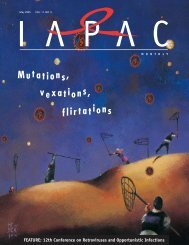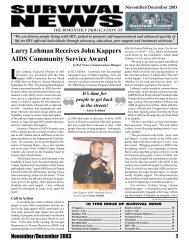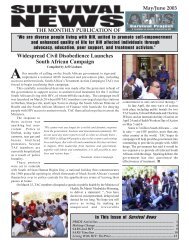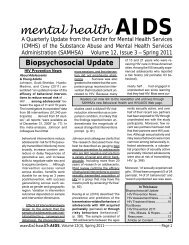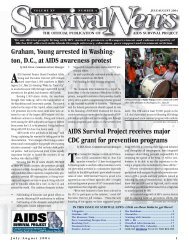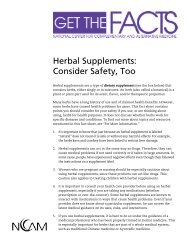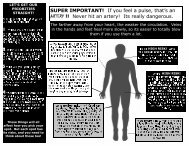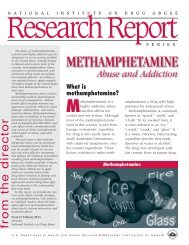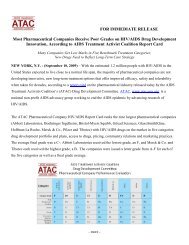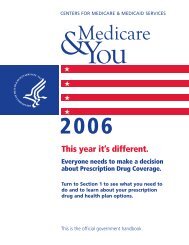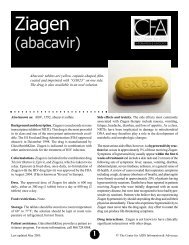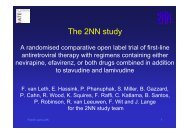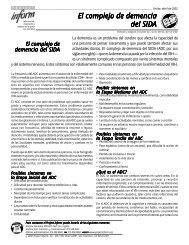Top 10 HIV Clinical Developments of 2008 - CD8 T cells - The Body
Top 10 HIV Clinical Developments of 2008 - CD8 T cells - The Body
Top 10 HIV Clinical Developments of 2008 - CD8 T cells - The Body
You also want an ePaper? Increase the reach of your titles
YUMPU automatically turns print PDFs into web optimized ePapers that Google loves.
34 • <strong>HIV</strong> JournalView—<strong>Top</strong> <strong>10</strong> <strong>HIV</strong> <strong>Clinical</strong> <strong>Developments</strong> <strong>of</strong> <strong>2008</strong><br />
approximately 150 days or less from more chronic<br />
infection.<br />
Specifically, the test looks at anti-<strong>HIV</strong> IgG<br />
(immunoglobulin G) levels compared to total<br />
IgG concentrations as it has been observed that<br />
anti-<strong>HIV</strong> antibodies increase relative to the total<br />
immunoglobulin level soon after acquisition <strong>of</strong> the<br />
virus. <strong>The</strong> combination <strong>of</strong> standard and BED testing<br />
is known as the serologic testing algorithm for<br />
recent <strong>HIV</strong> seroconversion (STARHS).<br />
In 2006, an estimated 39,400 people were<br />
diagnosed with <strong>HIV</strong> infection in the 22<br />
reporting states. Of the 6,864 <strong>HIV</strong>-seropositive<br />
specimens tested with the BED assay,<br />
31% were classified as recent infections.<br />
Extrapolating these data to the nation as a<br />
whole resulted in a new annual <strong>HIV</strong> incidence<br />
<strong>of</strong> 56,300 (95% CI, 48,200-64,500).<br />
This is a 40% increase from the previous estimates.<br />
Some have incorrectly misconstrued these results<br />
to mean there has been a 40% increase in the<br />
incidence <strong>of</strong> <strong>HIV</strong>—a misconception that should be<br />
corrected with an explanation that the analysis used<br />
a new method to estimate <strong>HIV</strong> incidence and found<br />
that prior estimates had been inaccurately low. In<br />
fact, overall <strong>HIV</strong> incidence has been relatively stable<br />
over the past few years, according to this report.<br />
FIGURE 18<br />
Over half <strong>of</strong> the new infections were among MSM and 45%<br />
were among black individuals. Using a model <strong>of</strong> extended<br />
back-calculation, the investigators estimated the number <strong>of</strong><br />
new infections from 1977 to 2006. <strong>The</strong> result was a picture<br />
<strong>of</strong> the domestic epidemic with a peak in incidence in the<br />
mid 1980s followed by a decline and smaller rise in the late<br />
1990s.<br />
<strong>The</strong>re were notable differences in trends <strong>of</strong> <strong>HIV</strong> incidence by<br />
race and risk category. MSM were the predominant group<br />
<strong>of</strong> infected persons early in the epidemic, but by 1988 to<br />
1989 the incidence in this population dropped below that <strong>of</strong><br />
injection drug users (IDUs).<br />
However, since 1990, <strong>HIV</strong> incidence among MSM has<br />
progressively increased. A disproportionate number <strong>of</strong> new<br />
infections have occurred among blacks; the incidence in<br />
this group climbed during the first decade <strong>of</strong> the epidemic<br />
and has remained fairly stable over the past several years.<br />
Incidence trends among women have also been largely<br />
unchanged in recent years.<br />
<strong>The</strong> Bottom Line<br />
<strong>The</strong> revised <strong>HIV</strong> incidence data paint a vivid and detailed<br />
picture <strong>of</strong> the epidemic in the United States and likely<br />
present a more accurate estimate <strong>of</strong> how many people<br />
acquire the virus. While the adjustment in the number <strong>of</strong><br />
new cases upward by approximately 40% was surprising,<br />
the finding that <strong>HIV</strong> remains concentrated among MSM and<br />
blacks is not.<br />
<strong>The</strong> rise, fall and resurgence<br />
<strong>of</strong> <strong>HIV</strong> among MSM is striking.<br />
Data from the National <strong>HIV</strong><br />
Behavioral Surveillance (NHBS)<br />
System point to an alarming<br />
increase in <strong>HIV</strong> acquisition<br />
among MSM between 13 to 24<br />
years <strong>of</strong> age, 41 demonstrating<br />
that <strong>of</strong>ficial and grassroots<br />
prevention messages are not<br />
adequately reaching or being<br />
received by this group <strong>of</strong> men.<br />
Likewise, the increased<br />
burden <strong>of</strong> <strong>HIV</strong> among African<br />
Americans can only invoke<br />
sadness. <strong>The</strong> Black AIDS<br />
Institute made the disturbing<br />
observation that if their<br />
numbers made up a separate<br />
country, <strong>HIV</strong>-infected African<br />
Americans would rank 16th in<br />
the world in <strong>HIV</strong> prevalence. 42



